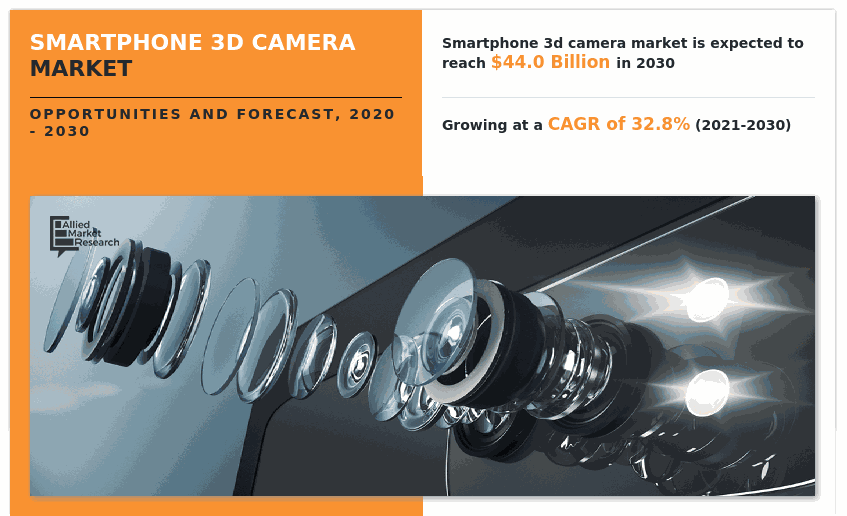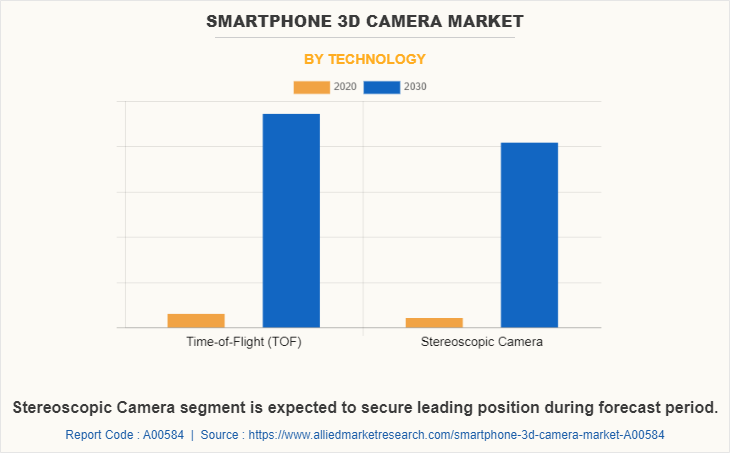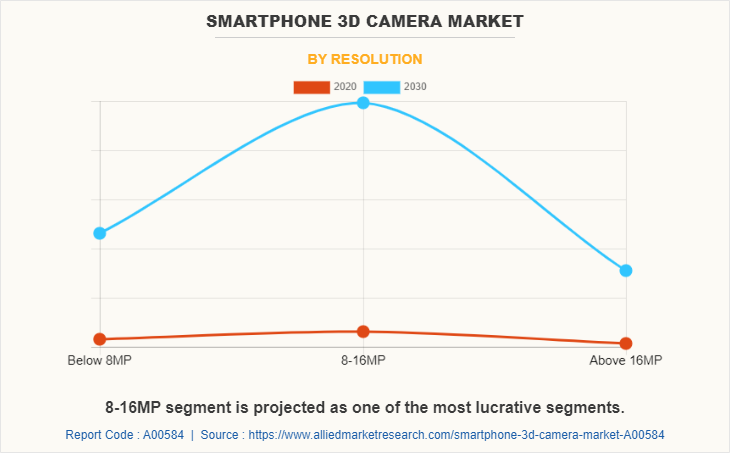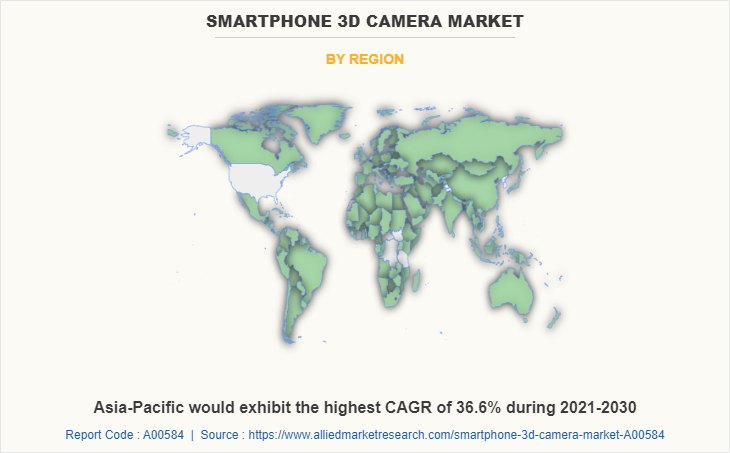Smartphone 3D Camera Market Outlook – 2030
The global smartphone 3D camera market size was valued at $2.55 billion in 2020 and is projected to reach $44.01 billion by 2030, growing at a CAGR of 32.8% from 2021 to 2030.
3D camera is an imaging device, that replicates the image the same as it is experienced via human binocular vision. In general, the device comprises two lenses. The 3D camera captures three-dimensional images, which enhances the overall quality of the visuals.
3D camera-equipped smartphones are one of the emerging technologies that provide enhanced quality pictures and videos to end users. Currently, the latest smartphones are integrated with 3D cameras that can sense movements, while taking pictures and enhance the picture quality.
Smartphone 3D cameras are gaining popularity among the young generation due to their attractive features, such as real sensing of the object, clarity, and HD performance. The increase in the adoption of smartphones and the rise in usage of 3D content across media, entertainment, and gaming industries are the key drivers for the growth of the smartphone 3D camera industry. 3D camera is a new concept in the smartphone market, and several manufacturers are adopting the 3D technology in smartphone cameras to cater to the growth in demand for smartphone 3D cameras from customers. These cameras are equipped with depth sensors, which can recorda quarter million 3D measurements per second and offer real-time 3D modeling of objects.

The smartphone 3D camera market revenue is anticipated to witness significant growth during the forecast period. This is attributed to factors, such as growth in adoption of smartphones, compatibility, high price, technological advancements, and availability of myriad features in 3D cameras. Moreover,the availability of advanced features in 3D cameras and rapid technological advancements are also expected to boost the growth of the smartphone 3D camera industry. However, integration of these cameras requires heavy configurations, such as large memory space and high-end processors to support all the 3D camera features and high pricing of these products is expected to hinder the Smartphone 3D Camera Market Opportunity.

Segment Overview
The smartphone 3D camera market is segmented based on technology, resolution, and region. Based on technology, the market is segmented into stereoscopic cameras and time-of-flight. The ToF 3D Camera technology is expected to witness an increase in adoption shortly, as this technology allows a smartphone to capture accurate real-time 3D images with a high degree of accuracy and sensitivity. However, camera manufacturers extensively use stereo vision technology owing to the simplicity of its implementation as compared to other technologies.
Based on resolution, the market is divided into 8MP, 8 MP to16 MP, and above 16 MP. To gain diverse insights globally, the smartphone 3D camera market trends are analyzed as per different geographies, such as North America, Europe, Asia-Pacific, and LAMEA.

Top Impacting Factors
The significant impacting factors in the smartphone 3D camera market outlook include growth in the adoption of smartphones and technological advancements in 3D cameras, which are expected to drive the smartphone 3D camera market growth. However, compatibility with all smartphones and the high cost of these gadgets hinder the smartphone 3D market growth. Conversely, the availability of myriad features in 3D cameras is projected to offer remunerative growth opportunities in the market. Each of these factors is anticipated to have a definite impact on the market during the forecast period.

Competitive Analysis
The key players profiled in the report include Infineon Technologies AG, Intel Corporation, Leica Camera AG, Microsoft Corporation, Panasonic Corporation, PMDtechnologies AG, Samsung Electronics Co. ,Ltd., Sharp Corporation, Sony Corporation, and Toshiba Corporation. These key players have adopted strategies, such as product portfolio expansion, mergers & acquisitions, agreements, geographical expansion, and collaborations to enhance their position in the smartphone 3D camera market.
Key Benefits For Stakeholders
- This study comprises an analytical depiction of the global smartphone 3D camera market size, current trends, and future estimations to depict the imminent investment pockets.
- The overall smartphone 3D camera market analysis is determined to understand the profitable trends to gain a stronger foothold.
- The report presents information related to key drivers, restraints, and opportunities with a detailed impact analysis.
- The smartphone 3D camera market forecast is quantitatively analyzed from 2021 to 2030 to benchmark the financial competency.
- Porter’s five forces analysis illustrates the potency of the buyers and suppliers in the industry.
- The report includes the smartphone 3D camera market share of key vendors and market trends.
Smartphone 3D Camera Market Report Highlights
| Aspects | Details |
| By Resolution |
|
| By Technology |
|
| By Region |
|
| Key Market Players | Leica Camera AG, Sharp Corporation, Intel Corporation, Infineon Technologies AG, Panasonic Corporation, Sony Corporation, Toshiba Corporation, Pmdtechnologies AG, Microsoft Corporation, Samsung Electronics Co. Ltd. |
| Other players in the value chain include: | Amkor Technologies, Bevel, HTC Corporation, Samsung Electronics Limited, LG Electronics |
Analyst Review
The smartphone 3D camera grows at a significant rate with increase in usage of advanced featured smartphone in the market. 3D camera equipped smartphone is one of the emerging technologies that provides enhanced quality pictures and videos to end users. Currently, the latest smartphones are integrated with 3D cameras that can sense movements, while taking pictures and enhance the picture quality. Smartphone 3D camera gains popularity among the young generation due to its attractive features, such as real sensing of the object, clarity, and HD performance.
The key factors that drive the growth of the global smartphone 3D camera market include, growth in adoption of smartphones, rise in usage of 3D content across media, entertainment, & gaming industries, and surge in inclination toward high end technology & advanced feature smartphones. At present, various developing countries such as India, China, Brazil, and others focus on building digital infrastructure. Therefore, rise in investment by the IT & telecom industry across these countries is expected to boost the growth of the smartphone 3D camera market. Hence, various developed economies are investing in these countries to build their business globally. However, the high initial cost and compatibility related to usage are anticipated to restrain the growth of the global market. Furthermore, the myriad features of smartphone 3D camera are expected to provide lucrative growth opportunities for the global market during the forecast period.
Among the analyzed geographical regions, Asia-Pacific is anticipated to be the fastest growing market in terms of adoption of smartphone 3D camera. The changes in consumer buying behavior, strong purchasing power, and rise in disposable income drive the growth of the market.
Infineon Technologies AG., Intel Corporation, Leica Camera AG, Microsoft Corporation, Panasonic Corporation, Pmdtechnologies AG, Samsung Electronics Co. Ltd., Sharp Corporation, Sony Corporation, and Toshiba Corporation are the key market players that occupy a significant revenue share in the smartphone 3D Camera Market.
North America is the largest regional market for smartphone 3D camera market
The global smartphone 3D camera industry size was valued at $8.89 billion in 2020
Infineon Technologies AG., Intel Corporation, Leica Camera AG, Microsoft Corporation, Panasonic Corporation, Pmdtechnologies AG, Samsung Electronics Co. Ltd., Sharp Corporation, Sony Corporation, and Toshiba Corporation are the key market players that occupy major revenue share in the smartphone 3D Camera Market
The 3D camera market is estimated to grow at a CAGR of 32.8% from 2021 to 2030.
Growth in adoption of smartphones and technological advancements in 3D camera, which are expected to drive the smartphone 3D camera market growth
The smartphone 3D camera market is segmented on the basis of technology, resolution, and region.
The key players have adopted strategies, such as product portfolio expansion, mergers & acquisitions, agreements, geographical expansion, and collaborations to enhance their position in the smartphone 3D camera market.
Stereoscopic Camera segment would grow at a highest CAGR of 34.1% during the forecast period.
Loading Table Of Content...



